5 Worst Strikes In American History
These 5 Worst Strikes in American History are not necessarily the ones with the largest number of striking workers. Factors taken into consideration include the impact of the strike on that particular industry, impact on other industries, impact on people and outcome of the strike.
Industry Related Strikes
1. 1912 Bread and Roses Strike
The Massachusetts AFL-CIO calls the Bread and Roses strike in Lawrence, Massachusetts, “One of the most prolific strikes in United States history.” Nearly twenty-five thousand textile workers responded to a pay cut of 32 cents a week by striking, encouraging other workers to strike and by damaging mill buildings and equipment. Women carried banners, one of which read “We want bread, and roses, too.” That banner gave the strike its well-known name.
Workers began sending their children to other towns to “maintain the resources for the striking workers,” and for safety reasons. Factory owners called in police to stop mothers from putting their children on trains after what History Channel calls the “children’s exodus” garnered tremendous support for striking workers. After police beat the women and children, a national outcry led to a full Congressional investigation.
In the aftermath, workers received a 15 per cent pay increase, higher overtime compensation and a promise from employers not to retaliate against striking workers.
2. 1946 Bituminous coal strike
The United Mine Workers of America (UMWA) workers chose April Fool’s Day 1946 as the day for 400,000 mine workers to strike for better pay, health benefits and safer working conditions. The strike lasted eight months, ending only after UMWA refused President Truman’s settlement offer and he fined the union $3.5 million. Union workers still prevailed, receiving most of their demands in a compromise with President Truman.
3. 1959 Steel Strike
The 1959 United Steelworkers of America Strike occurred when 500,000 steelworkers went on strike from July to November 1959 with widespread effects. The USWA says “the Department of Defense voiced concern that there would not be enough steel to meet national defense needs in a crisis.”
Workers demanded higher wages while management attempted to eliminate a contract clause that protected the jobs and hours of steelworkers. After President Eisenhower invoked the Taft-Hartley Act to order steelworkers back to work, USWA took the case to the U.S. Supreme Court. The Court upheld Eisenhower’s ruling, yet workers received higher wages and preserved the contract clause.
Although the 1970 postal worker’s strike initially affected only New York City, it quickly spread across the U.S. Unable to engage in collective bargaining under the Nixon administration, the strike also occurred over postal workers increasing complaints over wages, working conditions, benefits and management issues.
Nixon ordered the National Guard to replace striking workers with poor results. Within just two weeks, postal workers won most of their demands including “the right to negotiate.”
A Public Transit Strike
5. 2005 New York City Transit Strike
Public transportation in NYC came to a standstill from December 20-22, 1970 when members of the Transportation Workers Union went on strike after negotiations with the Metropolitan Transit Authority over wages, benefits and pensions failed. The strike left seven million New York commuters without public transportation in cold temperatures during the last week of the holiday shopping season.
A judge imposed a fine of $1 million each day on the TWU. That, along with taunts by Mayor Bloomberg calling striking workers “thugs” and Ed Koch comparing striking workers to terrorists resulted in a backlash from New York City Council members and African American clergy, according to People’s World.








